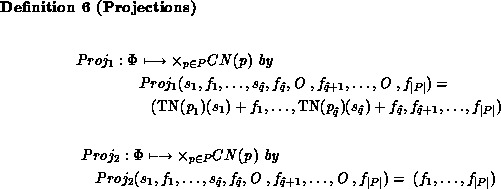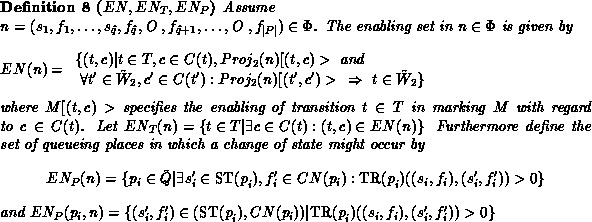Every QPN describes a stochastic process. Similar to the stochastic process specified by a GSPN [2], the states of this process might be vanishing or tangible. In vanishing states only immediate transitions are enabled and/or scheduling in immediate queueing places might occur. In tangible states a change to another state occurs due to the firing of a timed transition or some action concerning the service of a token in a queue of a timed queueing place.
For simplification of the formal description, we assume that timed queueing places
are numbered from  to
to  and immediate queueing places
from
and immediate queueing places
from  to
to
 .
Define
.
Define  and
and  Each state of a QPN is
an element of
Each state of a QPN is
an element of
 The state space, denoted by
The state space, denoted by  , of the QPN's corresponding
stochastic process can be constructed like the reachability set of PNs.
We assume that the state space is finite. The initial state is given
by
, of the QPN's corresponding
stochastic process can be constructed like the reachability set of PNs.
We assume that the state space is finite. The initial state is given
by  where
where  denotes the appropriate
element of
denotes the appropriate
element of  .
.
In order to define the successor states of a given state we need the following definitions.

 maps a state of the QPN onto the corresponding marking of
the underlying CPN taking also tokens in queues into consideration.
maps a state of the QPN onto the corresponding marking of
the underlying CPN taking also tokens in queues into consideration.
 neglects these tokens.
neglects these tokens.
Furthermore in contrast to ordinary QNs we have to consider the case of bulk arrivals at the queue of a queueing place. There are several possibilities of defining the queue's state after acceptance of the new arriving tokens, e.g. apply the AC-function successively to randomly chosen elements of the bulk or define an order on arriving tokens. We choose the last possibility, assuming that the colours of all places are indexed by natural numbers and the smallest index specifies the colour with the highest rank. In case of bulk arrivals the AC-function can recursively be applied to the arriving tokens, which is described by a function R-AC defined as follows.


The definition of  pays attention to the priority of immediate
transitions over timed transitions, thus if
pays attention to the priority of immediate
transitions over timed transitions, thus if  is non-empty,
either
is non-empty,
either  or
or  holds.
The successor states of a given state
holds.
The successor states of a given state  can be calculated
as follows.
can be calculated
as follows.
The relation between  and one of its successor states
and one of its successor states  will be denoted
by
will be denoted
by  and
and  is defined as the
reflexive and transitive closure of this relation.
is defined as the
reflexive and transitive closure of this relation.

In the next subsections we will discuss qualitative and quantitative analysis of QPNs.